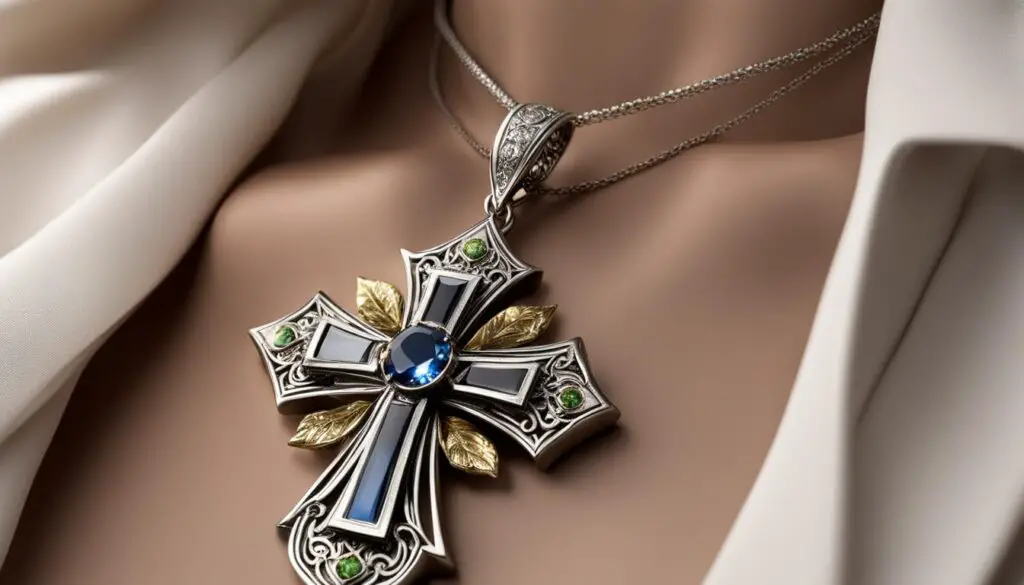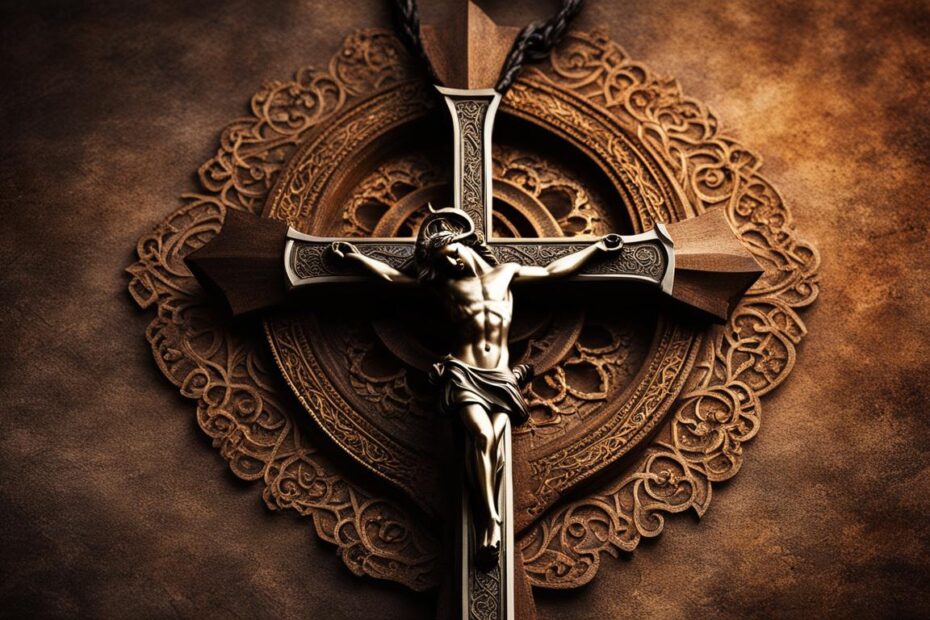The cross and crucifix are powerful symbols with deep meaning in Christianity and other cultures and religions. They represent sacrifice, transcendence, and the divine. Throughout history, the cross has held profound significance and has been used as a symbol of faith and devotion.
Christian prayer tools such as the cross necklace and crucifix pendant play a significant role in the practice of prayer. Worn or held during prayer, these tools serve as reminders of Jesus’ sacrifice and symbols of faith. The cross represents the earthly plane and the struggles of everyday life, while the crucifix represents the suffering and sacrifice of Jesus.
While the symbolism of the cross remains consistent, there may be variations in its interpretation among different Christian sects. Some emphasize the empty cross as a symbol of resurrection and hope, while others focus on the crucifix with Jesus on the cross as a reminder of his sacrifice. These variations reflect different theological beliefs and interpretations.
Crosses and crucifixes can be made from various materials, including metals such as gold, silver, and stainless steel, as well as wood, bone, and even precious gemstones. The choice of material often depends on personal preference and the desired aesthetic of the cross or crucifix.
The design of crosses and crucifixes has evolved over time. From simple wooden crosses to elaborately decorated crucifixes, changes in style, size, and symbolism have been influenced by cultural, artistic, and religious factors.
In addition to the cross and crucifix, there are lesser-known Christian prayer tools and religious icons. These may include icons of saints, rosary beads, prayer ropes, and religious medals. These tools can serve as visual aids for prayer and meditation.
The cross and crucifix have symbolism beyond Christianity and are also found in other religions and cultures. In Hinduism, Buddhism, and Celtic traditions, the cross may represent concepts like balance, harmony, and spiritual attainment.
In modern society, the cross and crucifix continue to hold significance for many people. They serve as reminders of faith, sources of comfort and inspiration, and symbols of hope. The cross is also often used in fashion and jewelry as a fashion statement or personal expression of religious beliefs.
Key Takeaways:
- The cross and crucifix are powerful symbols in Christianity and other religions.
- Christian prayer tools, such as cross necklaces and crucifix pendants, represent Jesus’ sacrifice and serve as symbols of faith.
- There may be variations in the symbolism of the cross among Christian sects.
- Crosses and crucifixes can be made from various materials, including metals and gemstones.
- The design of crosses and crucifixes has evolved over time, influenced by cultural and religious factors.
The Main Christian Prayer Tools and Their Symbolism
In Christianity, prayer is an essential part of spiritual practice, and there are several prayer tools that hold significant symbolism for believers. The main Christian prayer tools include the cross necklace and crucifix pendant. These items are not only worn as decorative accessories but are also held or touched during prayer, serving as tangible reminders of Jesus’ sacrifice and as symbols of faith.
The cross necklace, typically worn around the neck, holds deep meaning for Christians. It represents the earthly plane and the struggles of everyday life. The cross is a symbol of Jesus’ crucifixion and ultimate sacrifice for humanity’s salvation. As believers hold or touch the cross necklace, they are reminded of their own journey and the significance of faith in navigating life’s challenges.
Similarly, the crucifix pendant, featuring the image of Jesus on the cross, is another powerful symbol used during prayer. The crucifix represents the suffering and sacrifice of Jesus for the redemption of humankind. By holding or wearing a crucifix pendant, Christians connect with the profound love and devotion that Jesus demonstrated on the cross, strengthening their faith and deepening their spiritual connection.
The Cross Necklace and Crucifix Pendant in Practice
During prayer, Christians may hold the cross necklace or crucifix pendant in their hands, using them as focal points or aids in meditation. These prayer tools serve as tangible reminders of God’s presence and the sacrifice of Jesus, helping believers to center their thoughts and align their hearts with their spiritual devotion. Many find comfort and solace in the physical act of holding the cross or crucifix, feeling a sense of connection to God and finding strength in their faith.
While the cross necklace and crucifix pendant are commonly used by Christians across various denominations, the specific practices may vary. Some individuals may choose to wear the cross necklace or crucifix pendant throughout the day as a constant reminder of their faith, while others may reserve their use solely for prayer and religious ceremonies. The personal significance and experience associated with these prayer tools can differ widely, reflecting the unique spiritual journey of each individual.
As believers engage with the cross necklace and crucifix pendant during prayer, they tap into the rich symbolism of these Christian prayer tools. The cross represents redemption, salvation, and hope, while the crucifix embodies the depth of Jesus’ sacrifice and the divine love that transcends human understanding. Through the use of these prayer tools, Christians express their devotion and seek spiritual nourishment, finding strength, peace, and connection in their relationship with God.
| Prayer Tool | Symbolism |
|---|---|
| Cross Necklace | Earthly struggles, Jesus’ crucifixion, reminder of faith |
| Crucifix Pendant | Suffering and sacrifice of Jesus, love and devotion |
Variations Among Christian Sects
Different Christian sects may have variations in the symbolism of the cross. While the cross is a universal Christian symbol, its interpretation can differ among various denominations. These variations reflect the diverse theological beliefs and interpretations within the Christian faith.
One of the main variations in cross symbolism is the emphasis on the empty cross or the crucifix. Some Christian sects place greater importance on the empty cross as a symbol of resurrection and hope. They see the empty cross as a representation of Christ’s victory over death and the promise of eternal life.
On the other hand, some Christian sects focus on the crucifix, which includes an image of Jesus on the cross. The crucifix serves as a reminder of Jesus’ sacrifice and the profound love he had for humanity. For these sects, the crucifix is a powerful symbol of Jesus’ suffering and the redemption it offers.
These variations in cross symbolism highlight the different theological perspectives and practices within Christianity. While the central message of the cross remains the same across all Christian sects, the emphasis and interpretation of its symbolism may vary.
Cross Jewelry and the Symbolism of the Crucifix
One of the main Christian prayer tools that holds deep symbolism is cross jewelry, particularly the crucifix pendant. Cross jewelry is worn or held during prayer as a physical representation of faith and a reminder of Jesus’ sacrifice. It serves as a powerful symbol of devotion and spirituality. The crucifix, in particular, depicts Jesus on the cross, emphasizing the suffering and sacrifice that he endured for humanity.
The materials used for crafting cross jewelry and crucifixes vary, allowing for individual preferences and desired aesthetics. These pieces can be made from metals such as gold, silver, stainless steel, or even precious gemstones. Each material carries its own significance, adding depth to the symbolism of the cross or crucifix. For example, gold is often associated with divinity and purity, while silver represents integrity and grace.
The Symbolic Variations Among Christian Sects
Within different Christian sects, there can be variations in how the cross and crucifix are symbolized and interpreted. Some sects emphasize the empty cross as a symbol of resurrection and hope, focusing on the triumph of Jesus over death. Others place greater emphasis on the crucifix, highlighting the suffering and sacrifice of Jesus. These variations reflect different theological beliefs and interpretations within Christianity.
While the core symbolism remains consistent, the design of cross jewelry and crucifixes has undergone evolution over time. From simple wooden crosses to intricate and ornate designs, these symbols have adapted to reflect cultural, artistic, and religious influences. The evolution in design showcases the profound impact of these symbols throughout history and their continued relevance in modern society.

In addition to the cross and crucifix, there are lesser-known Christian prayer tools and religious icons that aid prayer and meditation. These include icons of saints, rosary beads, prayer ropes, and religious medals. Each of these tools serves as a visual aid, deepening the spiritual connection and serving as a physical reminder of the presence of faith in daily life.
Overall, the symbolism of cross jewelry and the crucifix holds a significant place in Christian devotion and spirituality. These powerful symbols not only serve as reminders of faith and sacrifice but also hold personal meaning and provide comfort to individuals seeking solace and inspiration.
| Material | Symbolic Meaning |
|---|---|
| Gold | Associated with divinity and purity |
| Silver | Represents integrity and grace |
| Stainless Steel | Symbolizes strength and resilience |
| Wood | Emphasizes simplicity, humility, and a connection to nature |
| Precious Gemstones | Adds beauty and value while symbolizing spiritual qualities |
Evolution of Cross/Crucifix Designs Over Time
The design of crosses and crucifixes has undergone significant changes over the centuries. From humble beginnings to intricate works of art, the evolution of these religious symbols reflects the cultural, artistic, and religious influences of different eras.
Early Crosses: Simple and Symbolic
In the early centuries of Christianity, crosses were primarily simple and symbolic. The earliest representations of the cross were in the form of the Latin cross, consisting of two intersecting lines with a longer vertical line and a shorter horizontal line. These early crosses were often made of wood and served as a stark reminder of Jesus’ crucifixion.
As Christianity gained prominence, crosses began to take on more elaborate designs. The addition of a circle behind the intersection of the lines gave rise to the Celtic cross, which symbolized the unity of the earthly and divine realms. The Chi-Rho symbol, formed by overlaying the first two letters of the Greek word for Christ, became a popular emblem on crosses during the Byzantine era.
The Influence of Art and Architecture
During the Middle Ages, crosses and crucifixes became prominent features in religious art and architecture. The crucifix, with the figure of Jesus on the cross, became a powerful symbol of devotion and sacrifice. Elaborate crucifixes adorned altars and were crafted with intricate details and embellishments.
The Renaissance period saw a resurgence of interest in classical art and architecture, influencing the design of crosses and crucifixes. Crosses became more stylized and ornate, with intricate carvings, inlays, and precious gems embedded in their structure. The Baroque period further added grandeur and opulence to cross designs, emphasizing the importance of faith and spirituality.
Contemporary Cross Designs
In modern times, cross designs have evolved to reflect the diverse artistic and cultural influences of our globalized world. While traditional designs still hold significance, contemporary cross jewelry and artwork often incorporate innovative materials and techniques. Stainless steel, titanium, and alternative metals are popular choices for cross jewelry, adding a touch of modernity to these timeless symbols.
Additionally, cross designs have explored new dimensions, incorporating elements of contemporary art, minimalism, and geometric shapes. These artistic interpretations aim to bridge the gap between tradition and innovation while preserving the inherent symbolism of the cross.
The evolution of cross and crucifix designs over time showcases the enduring significance of these religious symbols in various cultures and traditions. Whether simple or ornate, traditional or contemporary, the cross continues to be a powerful icon of faith, sacrifice, and transcendence.
| Symbol | Time Period | Description |
|---|---|---|
| Latin Cross | Early Christianity | The Latin cross consists of a longer vertical line intersected by a shorter horizontal line. |
| Celtic Cross | 5th century onwards | The Celtic cross features a circle behind the intersection of the lines, symbolizing the unity of the earthly and divine realms. |
| Chi-Rho Cross | Byzantine era | The Chi-Rho cross incorporates the Chi-Rho symbol, formed by overlaying the first two letters of the Greek word for Christ. |
| Elaborate Crucifixes | Middle Ages | Crucifixes during the Middle Ages were crafted with intricate details and embellishments, often adorned with precious gems. |
| Stylized Crosses | Renaissance | During the Renaissance, crosses became more stylized with ornate carvings, inlays, and precious gems. |
| Contemporary Crosses | Modern times | Contemporary cross designs incorporate innovative materials, techniques, and artistic interpretations. |
Lesser-Known Christian Prayer Tools
In addition to the well-known cross and crucifix, there are several lesser-known Christian prayer tools and religious icons that hold special significance for believers. These tools offer unique ways to connect with God and deepen one’s spirituality. Let’s explore some of these lesser-known prayer tools and their symbolism.
Icons of Saints
Icons of saints are religious paintings or images that depict holy individuals who have lived exemplary lives of faith. These icons serve as visual representations of the saints and are used in prayer and meditation. Believers may choose specific icons based on personal devotion or seek intercession from a particular saint for specific needs or concerns.
Rosary Beads
The rosary is a set of prayer beads used in Catholicism to recite prayers such as the Hail Mary and the Lord’s Prayer. Each bead represents a specific prayer, and the repetitive nature of using the rosary beads can help believers enter into a meditative state and draw closer to God. The rosary is also used to reflect on the life and teachings of Jesus and the Virgin Mary.
Prayer Ropes
Prayer ropes, or prayer knots, are used in Eastern Orthodox Christianity as a way to count prayers. These ropes consist of a string with multiple knots, typically 100 or 300, symbolizing the 108 passions to be conquered or the 300 virtues to be acquired. Believers hold the rope and move their fingers along the knots while reciting prayers, allowing them to focus their thoughts and intentions during prayer.
Religious Medals
Religious medals, often worn as pendants or carried as pocket tokens, feature images of saints or religious symbols. These medals serve as reminders of faith and can be used for personal devotion or as a source of comfort and protection. Believers may choose medals associated with specific saints or specific aspects of their faith.

Table: Comparison of Christian Prayer Tools
| Prayer Tool | Symbolism | Usage |
|---|---|---|
| Icons of Saints | Represent holy individuals and their virtues | Used for prayer, meditation, and seeking intercession from specific saints |
| Rosary Beads | Reflect on the life of Jesus and the Virgin Mary | Recite prayers and enter into a meditative state |
| Prayer Ropes | Represent the conquering of passions or acquisition of virtues | Count prayers and focus thoughts and intentions |
| Religious Medals | Serve as reminders of faith and offer comfort and protection | Worn or carried for personal devotion and connection to specific saints |
Cross/Crucifix and Its Symbolism in Other Religions
The cross and crucifix hold symbolism that transcends Christianity and can be found in various other religions and cultures. In Hinduism, for example, the cross is often associated with the swastika, a symbol of balance, prosperity, and spiritual attainment. The vertical and horizontal lines of the swastika intersect, representing the harmony between the physical and spiritual realms.
In Buddhism, the cross is depicted as the Dharmachakra, or the Wheel of Dharma. It represents the teachings of Buddha and the path to enlightenment. The wheel has eight spokes, symbolizing the Noble Eightfold Path, which leads to liberation from suffering.
The Celtic tradition also incorporates the cross into its symbolism, often combining it with intricate knotwork. The Celtic cross represents the intersection of the divine and earthly realms, as well as the eternal cycle of life, death, and rebirth. It serves as a reminder of the interconnectedness of all things.
“The cross has held deep significance and symbolism across cultures and religions, representing universal concepts such as balance, harmony, and spiritual attainment.”
While the precise meanings may vary, the presence of the cross in multiple religions underscores its enduring relevance and widespread recognition as a powerful symbol. It serves as a reminder of the shared human quest for spiritual understanding, irrespective of specific religious affiliations.
| Religion/Culture | Symbolism |
|---|---|
| Hinduism | Balance, prosperity, spiritual attainment |
| Buddhism | Teachings of Buddha, path to enlightenment |
| Celtic Tradition | Interconnectedness, eternal cycle of life |
The Significance of the Cross/Crucifix in Today’s Society
In modern society, the cross and crucifix continue to hold significant meaning and relevance for many individuals. These powerful symbols serve as potent reminders of faith, sources of comfort and inspiration, and tangible expressions of hope. Whether worn as jewelry, displayed in homes and churches, or used in prayer and meditation, the cross and crucifix hold a special place in the hearts of believers.
The cross, in its various forms, is often used in fashion and jewelry as a statement of personal style and a way to express religious beliefs. Cross necklaces and crucifix pendants are worn by Christians and non-Christians alike, showcasing their appreciation for the symbol’s beauty and the values it represents. The cross represents sacrifice, redemption, and the divine love of Jesus Christ, making it a powerful emblem of devotion.
In Christian prayer, the cross and crucifix hold deep symbolism. They serve as physical reminders of Jesus’ sacrifice on the cross for the salvation of humanity. By holding or wearing these prayer tools, believers can feel a sense of connection to Christ and draw strength from his example of selflessness and love. The cross represents the struggles and challenges of everyday life, while the crucifix portrays the suffering endured by Jesus and the promise of eternal life.
| Christian Prayer Tools | Symbolism |
|---|---|
| Cross Necklace | Represents sacrifice, redemption, and divine love |
| Crucifix Pendant | Symbolizes Jesus’ sacrifice and the promise of eternal life |
While the basic symbolism of the cross and crucifix remains consistent, there may be variations in interpretation among different Christian sects. Some sects may place more emphasis on the empty cross as a symbol of resurrection and hope, while others may focus on the crucifix with Jesus on the cross as a reminder of his sacrificial death. These variations reflect the diverse theological beliefs and traditions within the Christian faith.
The materials used for crafting crosses and crucifixes also vary widely. From traditional metals like gold, silver, and stainless steel to natural materials such as wood and bone, individuals can choose prayer tools that resonate with their personal preferences and aesthetics. Some may opt for crosses adorned with precious gemstones, adding a touch of elegance and symbolism to their religious jewelry.
Over time, the design of crosses and crucifixes has evolved to incorporate different artistic and cultural influences. From simple wooden crosses to intricately decorated crucifixes, the designs reflect the historical and regional contexts in which they originated. These changes in style and symbolism highlight the cross and crucifix’s adaptability and timeless appeal across different eras and traditions.
Conclusion
The cross and crucifix are not merely symbols but powerful representations of sacrifice, transcendence, and faith. They hold deep meaning in Christianity and other religions, serving as reminders of the divine and sources of inspiration.
Throughout history, the cross and crucifix have taken on various forms and symbolisms. Christian prayer tools such as cross necklaces and crucifix pendants are used as tangible reminders of Jesus’ sacrifice and as symbols of faith during prayer.
It is important to note that different Christian sects may have variations in the symbolism they attach to the cross. Some emphasize the empty cross as a symbol of resurrection and hope, while others focus on the crucifix with Jesus on the cross as a reminder of his sacrifice.
These prayer tools and religious icons can be made from a wide range of materials, including metals like gold and silver, as well as wood and precious gemstones. The choice of material often reflects personal preference and the desired aesthetic of the cross or crucifix.
As society evolves, so too does the design and use of these symbols. From simple wooden crosses to intricate and elaborately decorated crucifixes, there have been changes in style, size, and symbolism influenced by culture, art, and religious beliefs.
In addition to the cross and crucifix, lesser-known Christian prayer tools and religious icons include icons of saints, rosary beads, prayer ropes, and religious medals. These tools serve as visual aids for prayer and meditation, deepening one’s spiritual connection.
As we conclude, it is clear that the cross and crucifix continue to hold significant religious symbolism. Whether worn as jewelry, displayed in homes and churches, or used in prayer, these symbols serve as reminders of the importance of spirituality in our lives.
FAQ
What is the symbolism of the cross and crucifix?
The cross and crucifix symbolize sacrifice, transcendence, and the divine in Christianity and other cultures and religions.
How are cross necklaces and crucifix pendants used in prayer?
Cross necklaces and crucifix pendants are worn or held during prayer as reminders of Jesus’ sacrifice and symbols of faith.
Are there variations in the symbolism of the cross among different Christian sects?
Yes, different Christian sects may have variations in the symbolism of the cross, reflecting different theological beliefs and interpretations.
What materials are used to make crosses and crucifixes?
Crosses and crucifixes can be made from various materials, including metals like gold, silver, and stainless steel, as well as wood, bone, and precious gemstones.
How has the design of crosses and crucifixes evolved over time?
From simple wooden crosses to elaborately decorated crucifixes, the design of crosses and crucifixes has changed in style, size, and symbolism influenced by cultural, artistic, and religious factors.
What are some lesser-known Christian prayer tools and religious icons?
Lesser-known Christian prayer tools and religious icons include icons of saints, rosary beads, prayer ropes, and religious medals.
Do the cross and crucifix have symbolism in other religions?
Yes, the cross and crucifix are also found in other religions and cultures, such as Hinduism, Buddhism, and Celtic traditions, where they may represent concepts like balance, harmony, and spiritual attainment.
What is the significance of the cross and crucifix in today’s society?
In modern society, the cross and crucifix continue to hold significance as reminders of faith, sources of comfort and inspiration, and symbols of hope. They are also used in fashion and jewelry as personal expressions of religious beliefs.
What is the overall significance of the cross and crucifix?
The cross and crucifix are powerful symbols that represent sacrifice, transcendence, and faith. They hold deep meaning and serve as reminders of the importance of spirituality in our lives.









